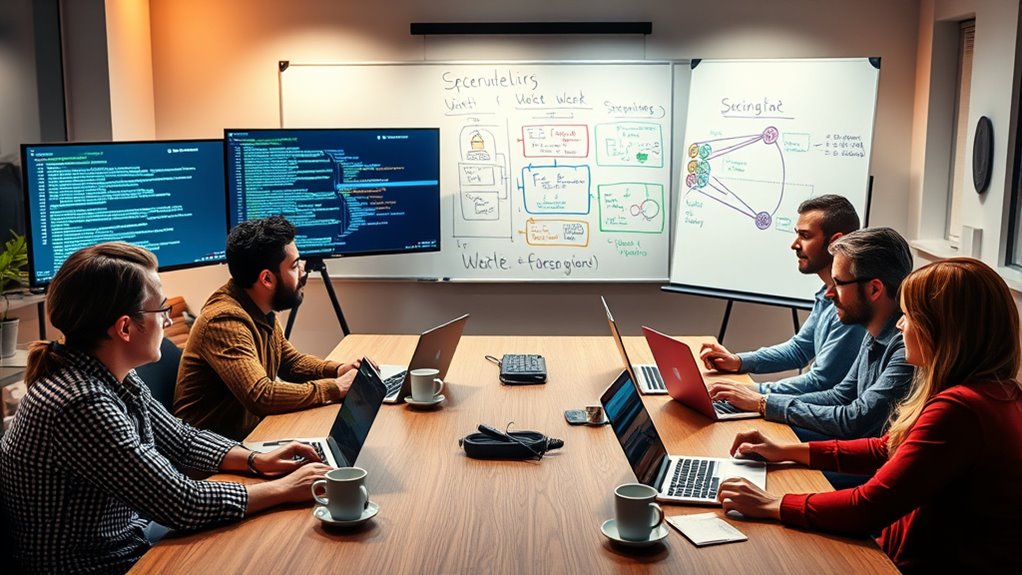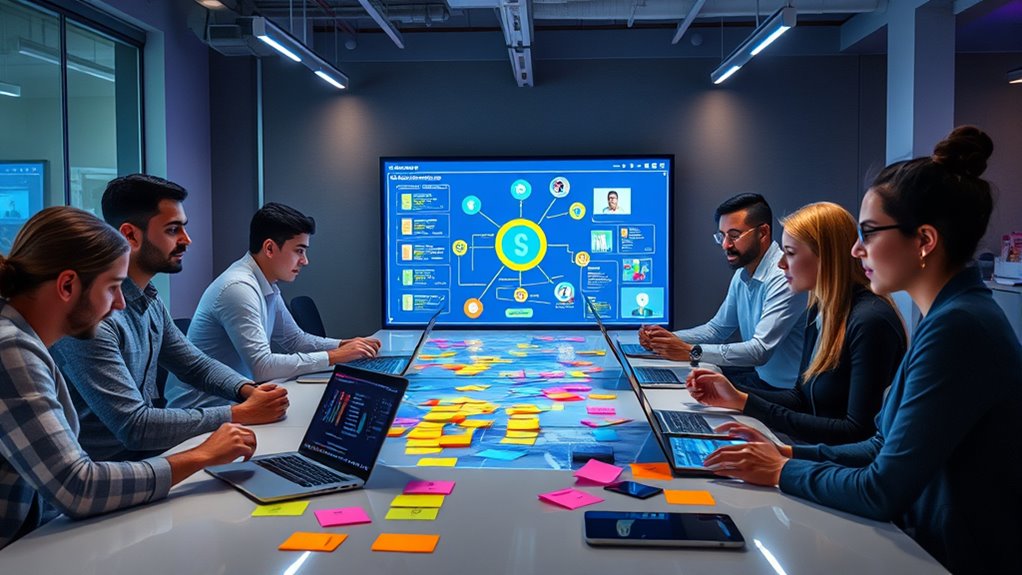DevSecOps bridges the gap between development and security by embedding security practices directly into your workflow. It promotes shared responsibility for security from the start, enabling faster, more secure application releases. By integrating automated compliance checks and real-time threat detection, DevSecOps helps you proactively manage vulnerabilities throughout the software lifecycle. This culture of collaboration enhances accountability and resilience. If you want to uncover more about its benefits and practices, there’s plenty more to explore.
Key Takeaways
- DevSecOps integrates security practices into the development workflow, ensuring security is a shared responsibility from project inception.
- Continuous threat detection in CI/CD pipelines proactively identifies vulnerabilities, reducing risks before deployment.
- Automated compliance checks ensure security standards are consistently met throughout the development lifecycle, saving time and resources.
- Collaboration between development and security teams fosters communication, aligning objectives and minimizing friction in workflows.
- Embedding security in every phase of the software development lifecycle enhances innovation and enables rapid, secure releases.

How can integrating security into your DevOps processes transform your software development lifecycle? It’s a question that’s becoming increasingly crucial as you navigate the complexities of modern software development. The intertwining of development and security—often referred to as DevSecOps—can substantially enhance the way you approach software creation. By embedding security practices into your DevOps workflow, you’re not just reacting to threats but proactively managing them, which can lead to more secure applications and faster deployments.
One of the key benefits of adopting a DevSecOps mindset is the implementation of automated compliance checks throughout your development process. Instead of waiting until the end of the development cycle to assess compliance, you can automate these checks at every stage. By doing so, you guarantee that security standards are met consistently, reducing the chances of vulnerabilities slipping through the cracks. This approach allows you to catch issues early, saving time and resources that would otherwise be spent on remediation after a product’s release. Automated compliance not only eases the burden on your team but also fosters a culture of accountability and vigilance regarding security.
Adopting a DevSecOps mindset enables automated compliance checks, catching vulnerabilities early and fostering a culture of security accountability.
In addition to automated compliance, DevSecOps enhances your threat detection capabilities. By integrating security tools into your CI/CD pipelines, you can monitor your applications in real time. This means you’re not just waiting for an issue to occur; you’re actively looking for potential threats as your code evolves. Incorporating tools for threat detection allows you to identify and address vulnerabilities before they can be exploited, markedly reducing the risk of a data breach or other security incidents. This proactive stance not only protects your organization but also builds trust with your users, who expect their data to be secure.
Moreover, aligning your development and security teams fosters collaboration and shared responsibility. When both teams work together from the beginning, you create a shared understanding of security requirements and the importance of safeguarding your applications. This collaboration enhances communication, minimizes friction, and streamlines the workflow. It’s no longer an “us versus them” mentality; instead, you’re all on the same team, focused on delivering secure, high-quality software.
In essence, shifting to a DevSecOps approach empowers you to build security into the fabric of your development lifecycle. With automated compliance and enhanced threat detection, you’re not only improving your security posture but also driving innovation and efficiency in your software development processes. Embrace DevSecOps, and transform how your team approaches security, making it an integral part of your development journey. Additionally, utilizing automated compliance checks within your DevSecOps strategy can significantly reduce the effort required for security validation throughout the development process.
Frequently Asked Questions
What Are the Main Tools Used in Devsecops?
The main tools used in DevSecOps include security automation tools like Snyk, Aqua, and SonarQube. These help you identify vulnerabilities early in the development process. For continuous compliance, tools such as Terraform and Jenkins can automate compliance checks and integrate security into your CI/CD pipeline. By leveraging these tools, you guarantee that your applications are secure and compliant from the start, reducing risks and enhancing overall security posture.
How Does Devsecops Impact Software Development Timelines?
DevSecOps can markedly impact software development timelines by fostering a security culture early in the process. When you integrate security practices throughout development, it often leads to fewer vulnerabilities and less rework. However, you might face integration challenges as teams adjust to new workflows and tools. Balancing speed and security requires ongoing communication, but the long-term benefits of a more secure product can ultimately save you time and resources down the line.
What Skills Are Essential for a Devsecops Professional?
To excel as a DevSecOps professional, you need a strong security mindset and collaboration skills. Imagine a team seamlessly integrating security measures while developing software—this is where you thrive. You’ll analyze threats, automate security processes, and work closely with developers to guarantee security is woven into every stage of development. Your ability to communicate effectively and foster teamwork is just as vital as your technical expertise in tools and practices.
Can Devsecops Be Implemented in Legacy Systems?
Yes, you can implement DevSecOps in legacy systems, but it comes with modernization challenges. You’ll need to focus on legacy integration, ensuring that security practices align with existing workflows without disrupting operations. Start by evaluating your current infrastructure, identify gaps in security, and gradually introduce automation and monitoring tools. By embracing incremental changes, you can enhance security while maintaining the functionality of your legacy systems.
How Do Organizations Measure Devsecops Success?
Organizations measure DevSecOps success by tracking security metrics and evaluating team collaboration. You should focus on key indicators like vulnerability detection rates, remediation times, and the frequency of security incidents. Regularly appraising how well teams communicate and work together on security practices is essential. Additionally, gathering feedback from team members can highlight areas for improvement, ensuring everyone’s aligned and committed to maintaining security throughout the development process.
Conclusion
In the quest for security, it’s amusing how we often forget that the best defense lies in collaboration. By integrating security into the DevOps process, you’re not just adding a layer of protection; you’re transforming the entire approach. Ironically, the very thing that can slow down development—security—can actually speed it up when everyone’s on the same page. So, embrace DevSecOps; after all, who knew that working together could be the secret sauce to faster, safer software?









